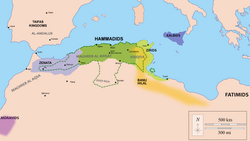
Back Hammadí AN حماديون Arabic Həmmadilər sülaləsi Azerbaijani Banu Hammad Catalan Hammadiden German Δυναστεία των Χαμαδιδών Greek Hammadidoj Esperanto Hamaditas Spanish Hamaditak Basque Hammadidit Finnish
Hammadid dynasty | |||||||||||||
|---|---|---|---|---|---|---|---|---|---|---|---|---|---|
| 1014–1152 | |||||||||||||
 Hammadid territory circa 1050 (in green), and extended territories (dotted line) controlled in certain periods | |||||||||||||
| Status | Nominal vassal of the Abbasid or Fatimid Caliphate[a] | ||||||||||||
| Capital | |||||||||||||
| Official languages | Arabic[1][2] | ||||||||||||
| Common languages | Maghrebi Arabic Berber languages | ||||||||||||
| Religion | |||||||||||||
| Government | Hereditary monarchy | ||||||||||||
| Emir | |||||||||||||
• c. 1007-1028 | Hammad (first) | ||||||||||||
• c. 1062-1088 | Al Nasir ibn Alnas | ||||||||||||
• c. 1121-1152 | Yahya ibn Abd al-Aziz (last) | ||||||||||||
| History | |||||||||||||
| 1014 | |||||||||||||
• Conquered by the Almohads | 1152 | ||||||||||||
| Currency | Dinar (gold coin) [3]: 240 | ||||||||||||
| |||||||||||||
| History of Algeria |
|---|
 |
The Hammadid dynasty (Arabic: الحماديون, romanized: Al-Hāmmādiyūn, lit. 'children of Hammad'), also known as the Hammadid Emirate or the Kingdom of Bejaia,[4]: 350 was a medieval Islamic kingdom[3]: 240 located in the central Maghreb,[5] encompassing present-day Algeria. It was established at the beginning of the 11th century when Hammad ibn Buluggin declared himself emir,[6] thus splitting the Zirid domains into two separate dynasties. Under the reign of Emir Al Nasir, the emirate briefly became the most important state in the Maghreb,[7] and reached its greatest territorial extent, stretching from Tlemcen in the west to Tunis in the east,[3]: 238 [4]: 362 [7] and from the Mediterranean Sea in the north to the desert oasis of Ouargla and Oued Righ in the south.[3]: 238 [8] While they briefly controlled the principality of Fez in the west and cities like Sfax, Kairouan, Laribus, and Tripoli to the east.[3]: 238 [9][10][7]
At first, Hammad built a fortified city that would serve as the capital for his newly declared kingdom.[5]: 40 [3]: 234 [6]: 20 [11]Later, upon the arrival of the Arabic Banu Hilal tribes, the capital would be replaced by another newly built city by Emir Al Nasir ibn Alnas called Al-Nāsiriyyah (from Arabic: الناصرية) and later renamed to Bejaia,[12]: 100 [7]: 45 [13][14] it would serve as the official capital of the Emirate by 1090 during the rule of Al-Mansur.[7]: 46 Both cities would grow to become one of the largest and most prosperous centers of the Maghreb,[14] with Bejaia housing more than 100,000 inhabitants.[13]: 59 [14][11] The Hammadids would subsequently clash with the Almoravids in the west and their cousins the Zirids in the east.[15][8]: 54 [6]: 80 The latter weakened with the rise of the prominent Normans in Sicily,[7]: 47 [11][16] who also confronted the Hammadids for the domination of Ifriqiya (modern-day Tunisia).[12]: 188 [6]: 98 [3]: 260 However, the Hammadids would face another challenge on their western borders with the growing force of the Almohad Caliphate,[7]: 47 and their emirate would finally be annexed by the Almohads in 1152 after a brief clash with them.[7]: 47 [11][8]: 58
Cite error: There are <ref group=lower-alpha> tags or {{efn}} templates on this page, but the references will not show without a {{reflist|group=lower-alpha}} template or {{notelist}} template (see the help page).
- ^ مبارك محمد الميلي. تاريخ الجزائر في القديم والحديث (in Arabic). p. 270.
- ^ Dr. Abdel Halim Aweys. The state of Bani Hammad, a Wonderful page of Algerian History (in Arabic). p. 248.
- ^ a b c d e f g Cite error: The named reference
:26was invoked but never defined (see the help page). - ^ a b Cite error: The named reference
:18was invoked but never defined (see the help page). - ^ a b Amar S. Baadj (11 August 2015). Saladin, the Almohads and the Banū Ghāniya: The Contest for North Africa. BRILL. p. 40. ISBN 978-90-04-29857-6.
- ^ a b c d Cite error: The named reference
:19was invoked but never defined (see the help page). - ^ a b c d e f g h Baadj, A.S. (2015). Saladin, the Almohads and the Banū Ghāniya: The Contest for North Africa (12th and 13th centuries). Studies in the History and Society of the Maghrib. Brill. p. 42. ISBN 978-90-04-29857-6. Retrieved 24 March 2022.
- ^ a b c Cite error: The named reference
:25was invoked but never defined (see the help page). - ^ Cite error: The named reference
:052was invoked but never defined (see the help page). - ^ Cite error: The named reference
Ilahiane 2006 55, 56was invoked but never defined (see the help page). - ^ a b c d Cite error: The named reference
Huebnerwas invoked but never defined (see the help page). - ^ a b Cite error: The named reference
:30was invoked but never defined (see the help page). - ^ a b Charles Féraud (2001). Histoire de Bougie (in French). Bouchène. p. 47. ISBN 978-2-912946-28-7.
- ^ a b c Benouis, Farida, Chérid, Houria, Drias, Lakhdar, Semar, Amine. Une architecture de la lumière. Les arts de l'Islam en Algérie (in French). Museum With No Frontiers, MWNF (Museum Ohne Grenzen). ISBN 978-3-902782-23-6.
{{cite book}}: CS1 maint: multiple names: authors list (link) - ^ Cite error: The named reference
:Ilahianewas invoked but never defined (see the help page). - ^ Abun-Nasr, Jamil (1987). A history of the Maghrib in the Islamic period. Cambridge University Press. ISBN 0521337674.
© MMXXIII Rich X Search. We shall prevail. All rights reserved. Rich X Search